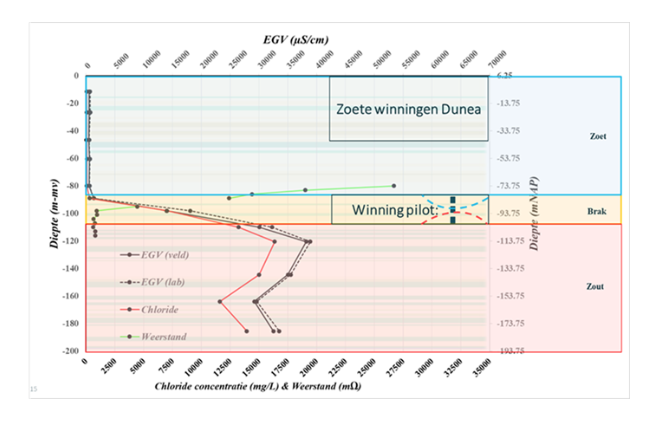
Programme, progress and results
Programme Freshman-project
- 2020 Q1: preparation and execution of pilot drilling
- 2020 Q2:
- monitoring water quality exploration well
- effects studies groundwater and nature
- 2020 Q3 + Q4:
- application for permits
- final design well field and purification unit
- Tendering well field and purification unit
- 2021 Q1-3: realization well field and purification unit
- 2021 Q4: test phase
- 2022-2023: extraction and purification of brackish groundwater
- 2024: experiments on capacity bridging
- 2025: finalization of project; final reporting
Progress
The design
The design of the installations (field of wells and purification) is ready. Two wells are provided and six monitoring wells at a distance of 5 to 120 meters from the extraction wells. In addition, an innovative measurement method (cross hole ERT) is planned in a 10 x 10 meter quadrant around the extraction wells, with which the effect of extraction on the sweet-salt distribution in the subsurface can be imaged in a three-dimensional way. The extraction will produce about 50 m3/hour of brackish water, of which 12 m3/hour will be desalinated. The excess brackish water, together with the residual product of the desalination (concentrate), will be discharged into the sewer. Agreements have been made with the sewer manager (Municipality of The Hague) and the relevant water board (HH Delfland).
The permits
Permits have been requested for the construction of the installations (environmental permit), for the pumping of brackish groundwater (Water Act) and for the discharge of the excess brackish water and concentrate on the sewer (ongoing). For the permit applications, studies have been carried out on the impact of the pilot on the environment (geohydrological and ecological); these impacts were minimal and are not a limitation for starting the pilot. The only remaining concern is nitrogen emissions during the construction of the well field; we are in discussions with the licensee about this.
Drilling
In support of the exploratory studies on the impact of the pilot on the environment, a pilot drilling has been carried out at the pilot site, which characterizes the soil composition and the sweet-salt distribution in the subsurface (up to 200 meters deep!). The result of this test drilling is in the figure below. Three different types of water can be distinguished. Up to a depth of 80 meters, the groundwater is sweet; then it goes through brackish (80-110 meters) to salt (deeper than 110 meters).
Understanding and modeling
In the pilot we will gain operational experience with extraction and purification (desalination by reverse osmosis) of brackish groundwater, and with extraction and control in a varying brackish/sweet groundwater environment. In this way, we gain a better understanding of the operation of the fresh/salt groundwater system on site, so that we can also better understand and model the larger concept of brackish water extraction. This is essential to know whether brackish water could also be extracted more widely in dunes and other coastal zones.
